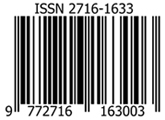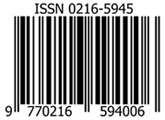KAJIAN SEMIOTIKA ROLAND BARTHES TENTANG AZAB KAUM SODOM
Abstract
Full Text:
PDFReferences
Al-Ashfahani, Ar-Raghib. Kamus Al-Qur’an 2. Jawa Barat: Pustaka Khazanah Fawa’id, 2017
Ar-Razi, Fakhruddin. Tafsir Al-Kabir. Beirut: Darul Al-Fikri, 1981
Ash-Shabuni, Muhammad Ali. Shafwatut Tafasir. Beirut: Darul Al-Qur’an Al-Karim, 1981
Az-Zamakhsyari. Tafsir Al-Kasyaf. 2nd ed. Riyadh: Maktabah Al-Abaikan, 1998
Barthes, Roland. Elemen-Elemen Semiologi. Edited by Edi AH Iyubenu. Yogyakarta: BASABASI, 2017
Fatah, Abdul. “Analisis Semiotika Roland Barthes Tentang Ashabul Fiil.” Kajian Sosial, Peradaban & Agama 5, no. 2 (2019)
Firdaus. “Konsep Manajemen Waktu Dalam Surat Al-’Ashr (Kajian Semiotika Al-Qur’an).” JIQTA: Jurnal Ilmu Al-Qur’an Dan Tafsir 1, no. 1 (2022): 1–18
Gusmian, Islah. Khazanah Tafsir Di Indonesia. Yogyakarta: LKis, 2013
Hamidah, and Ahmad Syadzali. “Analisis Semiotika Roland Barthes Tentang Fenomena Jilboobs.” Jurnal Studia Insania 4, no. 2 (2016): 117–26
Himawan, Anang Harris. Bukan Salah Tuhan Mengazab. Solo: Tiga Serangkai, 2007
Imron, Ali. Semiotika Al-Qur’an. Yogyakarta: Teras, 2011
Katsir, Ibnu. Kisah Para Nabi. Jakarta Timur: UMMUL QURA, 2013
Khalafulla, M. Ahmad. Al-Fann Al-Qashasy Fi Al-Qur’an Al-Karim. Beirut: Muassasah al-Intisyar al-’Araby, 1999
Shihab, M. Quraish. Tafsir Al-Misbah. Jakarta: Lentera Hati, 2002
Sya’rawi, Muhammad Mutawalli. Tafsir Sya’rawi. Medan: Duta Azhar, 2007
Taufiq, Wildan. Semiotika Untuk Kajian Sastra Dan Al-Qur’an. Bandung: YRAMA WIDYA, 2016
Umaroh, Dewi. “Makna ’Abasa Nabi Muhammad Dalam Al-Qur’an (Aplikasi Semiotika Roland Barthes Terhadap QS.’Abasa(80):1)” 5, no. 2 (2020): 117–27
Wijaya, Irfan Rhamdan. “Pesan Pendidikan Al-Qur’an Terhadap Kaum Gay.” Rayah Al-Islam 1, no. 1 (2016)
Yulianti, Frizky. “Komodifikasi Idealisme Feminisme Dalam Industri Musik (Analisis Semiotika Roland Barthes Dalam Video Klip Beyonce ‘Run The World’).” Komunikator 3, no. 1 (2011)
Zoes, Aart Van. Serba-Serbi Semiotika. Jakarta: Gramedia Pustaka, 1992
Refbacks
- There are currently no refbacks.

This work is licensed under a
Creative Commons Attribution-NonCommercial-ShareAlike 4.0 International License.




